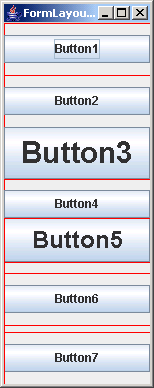FormLayout: Button Stack Builder Example 1

/*
Code revised from Desktop Java Live:
http://www.sourcebeat.com/downloads/
*/
import java.awt.BorderLayout;
import javax.swing.JButton;
import javax.swing.JFrame;
import javax.swing.JPanel;
import com.jgoodies.forms.builder.ButtonStackBuilder;
import com.jgoodies.forms.debug.FormDebugPanel;
public class ButtonStackBuilderExample1 extends JPanel {
public ButtonStackBuilderExample1() {
super(new BorderLayout());
ButtonStackBuilder builder = new ButtonStackBuilder(new FormDebugPanel());
builder.addGridded(new JButton("Button1"));
builder.addGridded(new JButton("Button2"));
JButton bigGriddedButton = new JButton("Button3");
bigGriddedButton.setFont(bigGriddedButton.getFont().deriveFont(30.0f));
builder.addGridded(bigGriddedButton);
builder.addUnrelatedGap();
builder.addFixed(new JButton("Button4"));
JButton bigFixedButton = new JButton("Button5");
bigFixedButton.setFont(bigFixedButton.getFont().deriveFont(24.0f));
builder.addFixed(bigFixedButton);
builder.addUnrelatedGap();
builder.addButtons(new JButton[]{new JButton("Button6"), new JButton("Button7")});
add(builder.getPanel());
}
public static void main(String[] a){
JFrame f = new JFrame("FormLayout: Button Stack Builder Example 1");
f.setDefaultCloseOperation(2);
f.add(new ButtonStackBuilderExample1());
f.pack();
f.setVisible(true);
}
}
 jgoodiesFormLayoutReady.zip( 98 k)
jgoodiesFormLayoutReady.zip( 98 k)Related examples in the same category